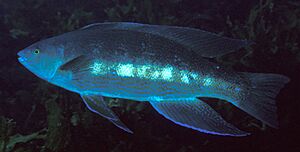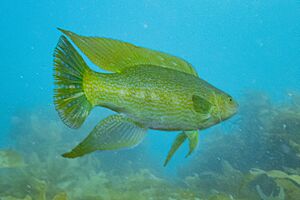Greenbone facts for kids
Odax pullus, also known as the greenbone, butterfish, or by its Māori language name rarī, is a type of fish. It's a weed whiting from the family called Odacidae. You can find these fish swimming around New Zealand. They are sometimes caught by local commercial fisheries for food, but they are not a major catch.
Quick facts for kids Greenbone |
|
|---|---|
 |
|
| Conservation status | |
| Scientific classification | |
| Synonyms | |
|
Contents
Discovering the Greenbone Fish
Greenbone fish have an interesting life cycle. They are what scientists call protogynous hermaphrodites. This means they are born female. As they grow older, some of the females will change and become male.
How Greenbones Change Color and Size
Young greenbone fish start out with a bright golden-yellow color. As they get a bit older, they turn a dark green-blue. Adult fish are usually brown-yellow.
These fish can grow up to about 40 centimeters (16 inches) long. The biggest ones recorded have weighed around 1.5 kilograms (3.3 pounds). Once a greenbone fish reaches about 40 centimeters in length, about half of them will change into males. These male fish are easy to spot because they turn a bright blue color!
Where Do Greenbones Live?
Odax pullus fish are very common in the coastal waters of New Zealand. You can find many of them, especially around the South Island. Their home range also includes the Chatham Islands, Antipodes Islands, and Bounty Islands.
However, you won't find them around the Three Kings Islands. In that area, a similar fish called the bluefinned butterfish takes their place. The bluefinned butterfish is endemic to that area, meaning it's only found there.
Their Home Environment
Greenbones like to live in shallow, rocky areas. They especially enjoy places where there's a lot of brown seaweed growing. Their favorite type of seaweed is called Carpophyllum.
What Do Greenbones Eat?
Greenbone fish are mostly plant-eaters, which means they are herbivores. Their main food source is brown seaweeds. They spend their time grazing on these plants in their underwater homes.
Greenbones and People
The rarī, or greenbone fish, has been an important food source for the Māori people for a long time. Interestingly, these fish also gained a reputation in Māori stories for being troublemakers! Over time, the name "rarī" even started to be used to describe people who caused trouble.
Greenbones in Māori Culture
This fish was eaten more often in the southern parts of New Zealand. Māori people traditionally caught them using large pole nets. They would even use kelp as a way to hide the nets, making them blend in with the environment.
Early European Views
When early European settlers arrived, they also didn't think much of the greenbone fish. However, this changed in the 1920s. The Department of Health started a public health campaign. They encouraged people to eat greenbone fish because it has high levels of iodine, which is good for your health!



